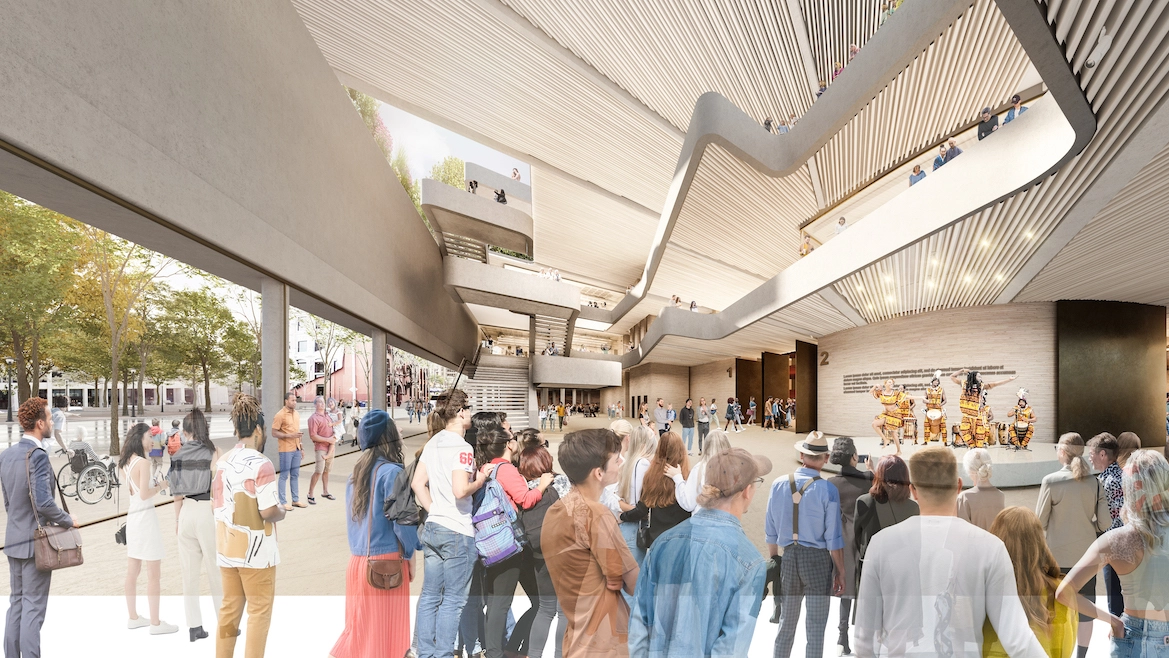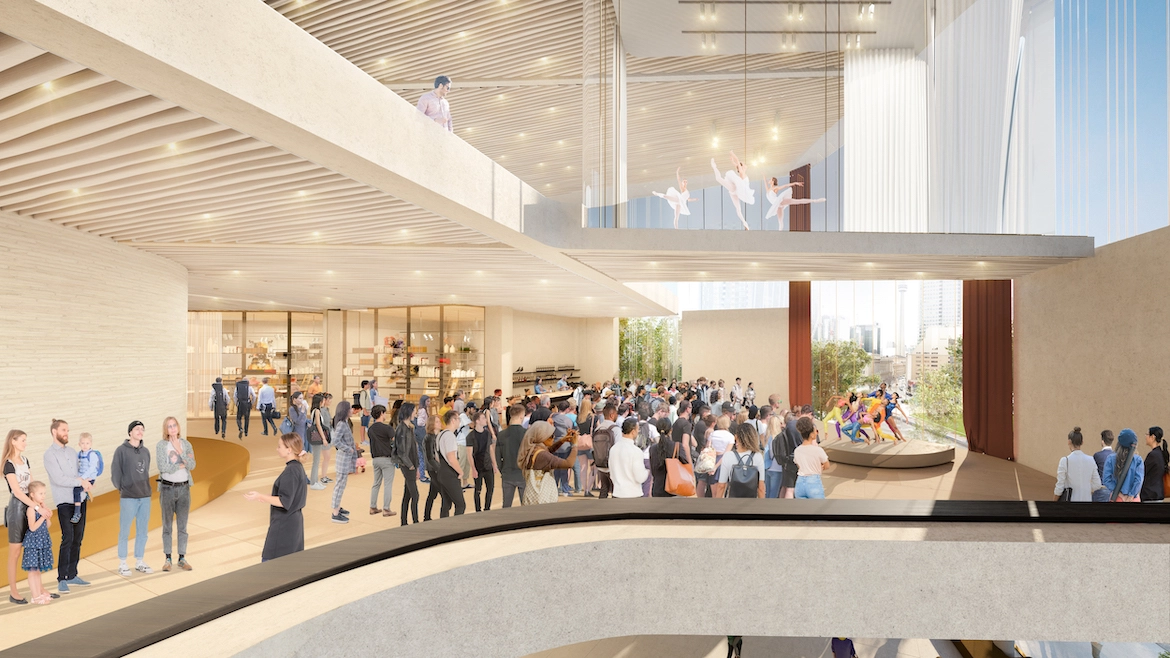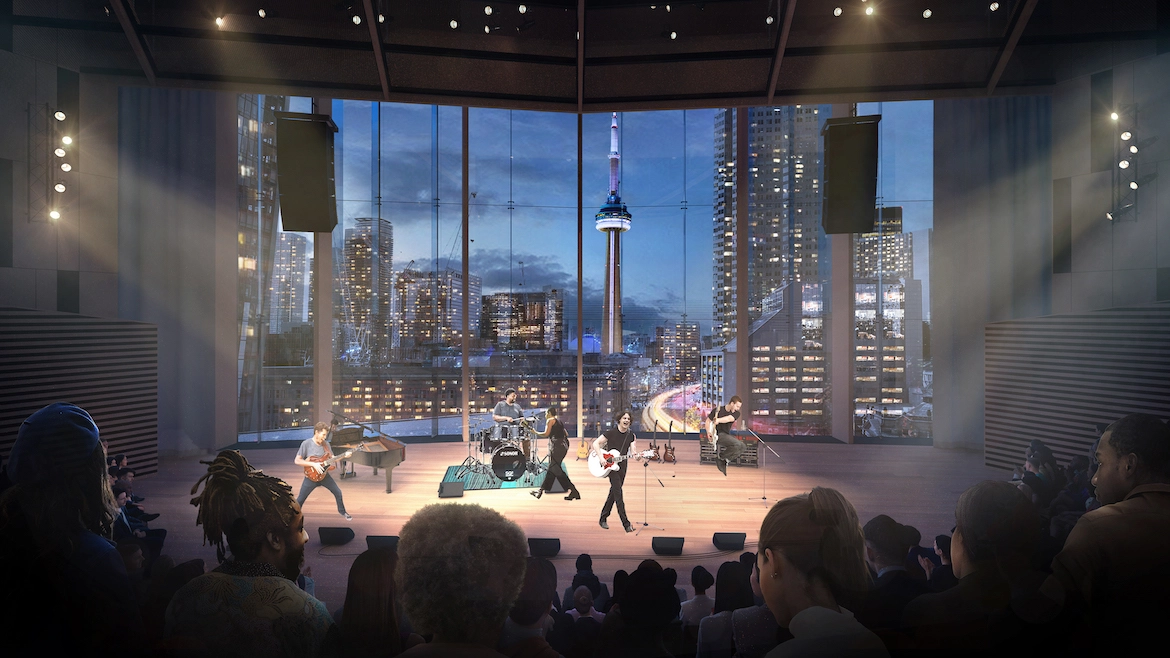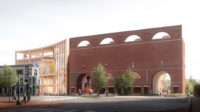Hariri Pontarini Architects–Led Team Wins Design Competition for Toronto's St. Lawrence Centre for the Arts


Expanded public space on the ground level opens on two sides to a park and new plaza. Image courtesy Hariri Pontarini Architects, LMN Architects, Tawaw Architecture Collective, Smoke Architecture, SLA

A newly envisioned space, The Hive, includes studios, rehearsal rooms, and informal performance areas. Image courtesy Hariri Pontarini Architects, LMN Architects, Tawaw Architecture Collective, Smoke Architecture, SLA





A potential second act for an aging performing arts complex that has served as a beloved cultural anchor in downtown Toronto for more than five decades, has come into focus.
The winner in a design competition seeking proposals for a dramatically revamped St. Lawrence Centre for the Arts (STLC) was announced late last week by multi-arts organization TO Live, which operates the dual-theater complex, and the (relatively new) centralized city real estate agency CreateTO. Selected by a seven-member jury panel from a shortlist of five concepts, the winning proposal was submitted into the two-staged competition by a team led by hometown firm Hariri Pontarini Architects (HPA) and joined by Seattle’s LMN Architects, Danish landscape and urban design studio SLA, and two Indigenous-owned practices: the Ontario-based Smoke Architecture and Tawaw Architecture Collective, based in Phoenix. Dubbed Transparence, the proposal envisions rotating the central axis of the building’s main theater by 90 degrees to make way for a new public plaza while also cloaking the Brutalist landmark in a high-performance transparent facade.

The main theatre would be reconfigured to support a wide range of performance types. Image courtesy Hariri Pontarini Architects, LMN Architects, Tawaw Architecture Collective, Smoke Architecture, SLA
Meg Graham, partner at Toronto architecture studio Superkül who served as jury chair, praised the team’s concept for “masterfully bringing the theater to the street, and the street to the theater – creating in one deft move a seamless theater and civic space open to the world.”
Each of the five shortlisted proposals were pitched to the public during a well-attended March 7 presentation forum held at the STLC’s Jane Mallett Theatre shortly before jury deliberations commenced. The competition attracted a slate of impressive contenders, including firms known for high-profile cultural projects. Each team was led by a Toronto firm and included an Indigenous design partner. The Transparence team, which incorporated multiple Indigenous design elements into its proposal such as a ceremonial circle fire and an exterior inspired by beaded Wampum belts, included two such partners.
The four other finalist teams were: Brook McIlroy with Trahan Architects and Hood Design Studio; Diamond Schmitt Architects with Smoke Architecture and MVVA; RDHA with Mecanoo, Two Row Architect, and NAK Design Strategies; and Zeidler Architecture with Diller Scofidio + Renfro, Two Row Architect, and PLANT Architect.
Designed by noted Canadian architect Gordon Adamson and completed in 1970 at Front and Scott Streets opposite Berczy Park, the outmoded and inefficient STLC has been subject to ongoing conversations regarding its future; full demolition has been a possibility and some of the shortlisted competition proposals maintain very little of the original building. Jurors considered sustainability, and accessibility when selecting a winner. Finalists were also required to respect heritage guidelines in place for the Old Tow site while enhancing the center’s connection to the public realm.

Boasting city views, the smaller upper-level theater, Acoustic Hall, includes lounge areas and connects to a spacious event terrace. Image courtesy Hariri Pontarini Architects, LMN Architects, Tawaw Architecture Collective, Smoke Architecture, SLA
Describing the Transparence scheme as “an emphatic embrace of openness between spaces of performance and the city,” HPA founding partner Siamak Hariri said in a statement that the team “sought a design that is radically accessible, radically open, so that it brings the city in and also pushes out to the city in a way that makes it highly visible, disarming, and welcoming.”
“By opening up the building and inviting the public with more accessible space, the energy of live performance will enrich the life of downtown Toronto,” added LMN principal Cameron Irwin, describing the team’s vision of pivoting the larger of the STLC’s two existing side-by-side theaters, the Bluma Appel Theatre, to yield a public plaza on Scott Street that could function as a new venue for public programming.
The reimagined facility would be the first zero-carbon performing arts center in Canada and include an extensive overhaul of the STLC’s two venues—the 600–1,000-seat main theater and a more intimate 300-seat acoustic hall to “support maximum configuration flexibility with transformable components of retractable seating and partitions.”

The current St. Lawrence Centre for the Arts, completed in 1970 in downtown Toronto's Old Town district. Photo courtesy Hariri Pontarini Architects, LMN Architects, Tawaw Architecture Collective, Smoke Architecture, SLA
“These spaces are intended to allow for new and innovative interpretations of how performance can happen and push the boundaries of theatrical expression,” the team explained.
Maximizing the reuse of the current structure, the new center’s second and third floors would be dedicated to studios, rehearsal rooms, and informal performance areas, and provide access to a sprawling green terrace. The refreshed exterior of the STLC as mentioned, is inspired by Wampum belts. “We took the symbolic and figurative quality of the belt, which brings together diverse groups, to create one long, luminous line from end to end, gathering and unifying the complex in a single move envisioned as an embrace of culture and connection to community,” said Hariri.
Next up, Transparence will be presented to Toronto City Council later in the year.








